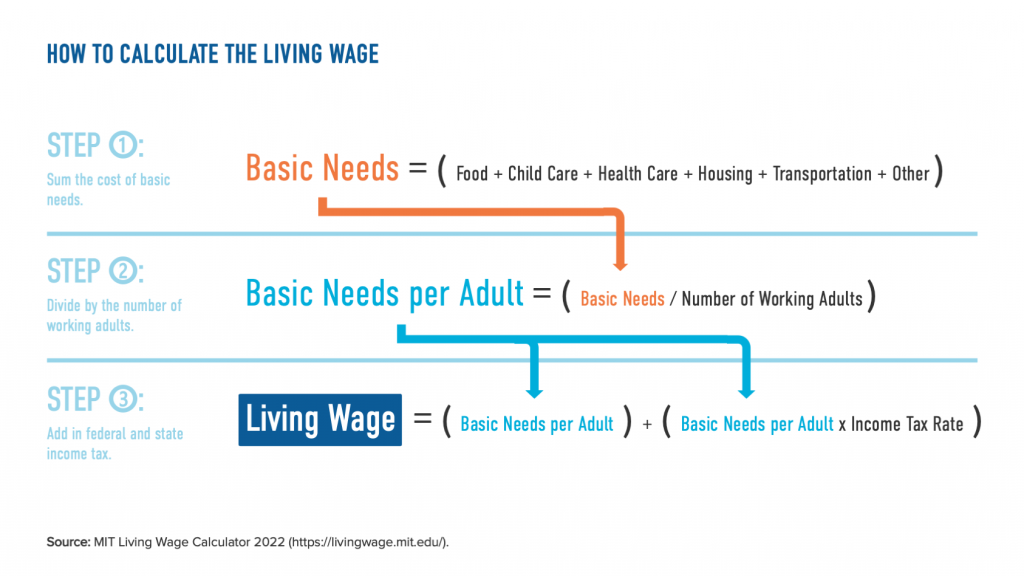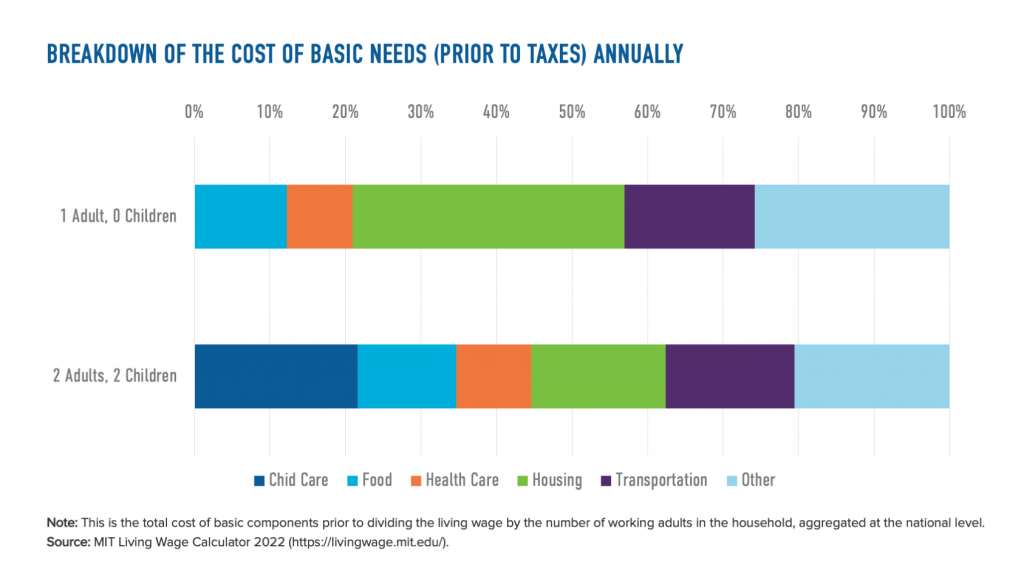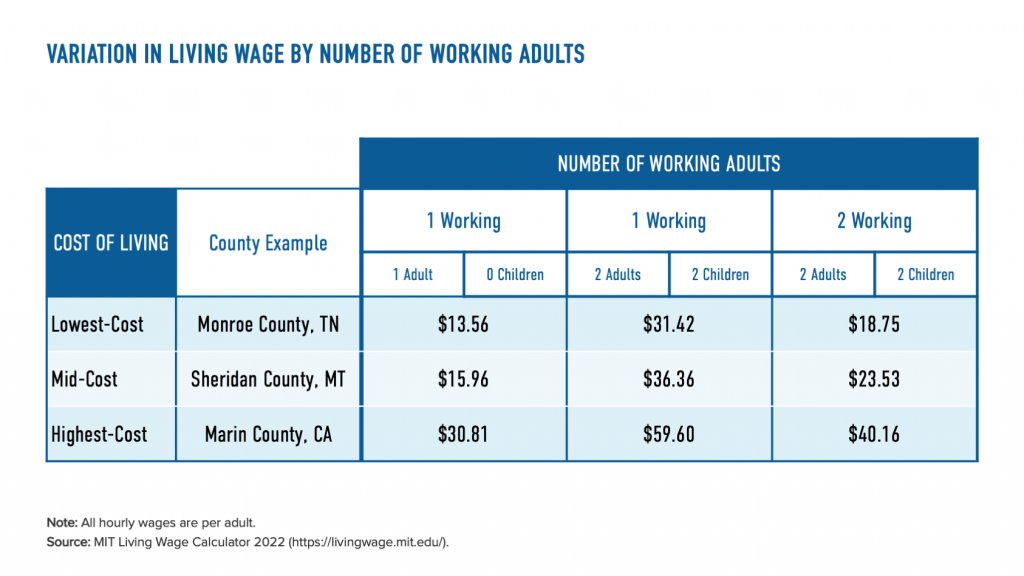JUST Report
What a Living Wage Is and Why Businesses Should Use It as a Benchmark
October 7, 2022
This report was co-authored by Senior Director of Research Kavya Vaghul, Director of Programs and Engagement Kelley-Frances Fenelon, and JUST Advisor and Founder of the MIT Living Wage Calculator Amy K. Glasmeier.
Paying a fair, living wage consistently rises to the top of JUST Capital’s annual survey of the American public’s priorities for just business practices. That prioritization should come as no surprise: Recent research from JUST Capital and new partner Revelio Labs estimates that over 50% of Russell 1000 employees in the U.S. – roughly 11.1 million workers – aren’t making enough to support a family of two adults and two children, even with one of those adults working full-time. What’s more, a GAO study found an estimated 5.7 million Medicaid enrollees and 4.7 million SNAP recipients in 2018 worked full-time hours, and that private sector employees made up fully 90% of all wage-earning adults receiving these benefits. That amounts to a federal subsidy of private sector employers, paid for by the American people. This reality is at odds with Americans’ expectation that leading companies pay their workers a fair, living wage. There is broad agreement across demographic groups, income brackets, and partisan affiliation that workers should earn enough to get by. But how much is enough?
At JUST Capital, we turn to the living wage as a preliminary answer. The current concept of a living wage has a long history in the United States, with the American Federation of Labor calling for a living wage from the time of its founding in the late 1800s, and FDR echoing that refrain decades later during the New Deal era with the advent of a federal minimum wage. It was regalvinized in the 1990s when community organizers and faith-based organizations rallied around municipal living wage ordinances and fought for living wage as a human right within global supply chains.
All these efforts were rooted in a common goal: to ensure that wages earned from working a full time (40 hours a week) job provided enough for a worker and their family to meet their basic budgetary needs.
Today, the concept of a living wage persists and has been increasingly used as a powerful benchmark that companies can leverage to ensure that they’re providing jobs that pay workers family-sustaining wages rather than perpetuating poverty. Other, sometimes more familiar, wage floors also exist, such as policy-based minimum wage rates, the poverty wage, and the wage advocated in a more recent wage-based movement – the Fight for 15. But unlike living wage estimates, federal and even subnational minimum wages are outstripped by the rising costs of goods and services, and the Fight for 15’s anchoring on a single wage similarly has been subjected to inflation: today, that $15 would need to be over $19 to have the same purchasing power when the movement started in 2012. Calculations of living wage estimates are explicitly responsive to such changes and their impact on workers’ budgets. When used by employers to gauge the right wage rate, that attunement to worker needs pays off beyond employee well-being. In fact, we know this attention to employee financial security impacts recruitment, retention, productivity, customer satisfaction, and more.
In this explainer, we walk through the definition of a living wage, the components of the basic needs budget used to calculate a living wage estimate, and why a living wage estimate varies based on family size, geographic location, and other factors. While living wage estimates are an important tool across global employee populations and supply chains, in this piece we focus primarily on living wage calculations within the U.S. context, as it is a critical feature of job quality in America, too.
Defining “Living Wage”
At its simplest, a living wage is the amount of money needed for a given worker to cover the cost of their family’s minimum or basic needs where they live.
What are basic needs?
There are a number of leading research organizations that produce living wage estimates for the United States using slightly different albeit rigorous methodological approaches – like University of Washington’s Self Sufficiency Standard, Economic Policy Institute’s Family Budget Calculator, Living Wage For US, and MIT Living Wage Calculator, among others. While we at JUST Capital utilize the MIT Living Wage Calculator, first created in 2004 by MIT Department of Urban Studies and Planning professor and JUST advisor Amy Glasmeier, there is general alignment on the components of basic needs. For example, the Living Wage Calculator’s basic needs budget includes:
- Food costs are based on the USDA’s low-cost food plan, doesn’t include any food prepared outside of the home and assumes that families purchase less expensive items. These costs are adjusted by region.
- Childcare costs are based on county or region-level data from state market rate surveys and information shared by local providers and calibrated to reflect annual rates and inflation.
- Health care costs are based on survey and analysis-based household estimates and adjusted for inflation. These costs include the price of employer-sponsored health insurance, medical services and supplies, and medications.
- Housing costs are based on regional rental expenses using the Department of Housing and Urban Development’s Fair Market Rents (FMR) estimates, assuming unit size increases with family size. The FMR includes utilities adjusted by unit size.
- Transportation costs are drawn from the Bureau of Labor Statistics Consumer Expenditure Survey and include expenses associated with used cars and trucks, gasoline and oil, public transit, and other vehicle-related expenses including maintenance, insurance, and financing.
- Other necessities covers clothing, personal care, housekeeping supplies, broadband and cell service, and civic engagement costs. Broadband service is estimated by lowest cost regional plans, cell service by prepaid plan averages, and other items by survey-based, inflation-adjusted household data. Civic engagement costs come from inflation-adjusted survey data on entertainment, fees and admissions, pets, toys, hobbies, education, playground and other equipment, and reading.
- Taxes are based on federal and state income tax rates, with property and sales taxes taken into consideration in calculations of other categories.
Other living wage estimates may exclude civic engagement costs or may add in a small margin to cover unexpected events and emergencies. Regardless of source for the living wage estimate, it is important to note that these calculations assume that families will select the lowest cost option for each component, which is not necessarily families’ preferred option. As such, basic needs do not include meals that aren’t home cooked, whether pre-prepared or from a restaurant; leisure time, holidays, or vacation; and savings or financial planning for the future.
How is the living wage calculated?
After an estimate is generated for the cost of each basic need, the net living wage is calculated by summing across each component cost that is relevant to a given family. The net living wage is then divided by the total number of workers in the family, representing the amount that an individual would need to earn to support themselves and their family, taking into account the earnings of other working adults. Finally, federal and state income taxes – which are calculated by multiplying the marginal tax rate by the basic needs budget for one working individual in a family – are added to the total in order to render the gross living wage. In sum, the gross living wage is the amount an individual worker would need to earn prior to taxes in order to meet their family’s basic needs where they live.

The figure below shows a breakdown of how each expense contributes to the living wage estimate prior to factoring in other workers and income taxes. In other words, which basic needs are the most or least expensive? Housing is one of the biggest costs for families, and it makes up over a third of the basic needs budget for a single individual. In families with children, the high cost of childcare surpasses housing at about a fifth of a family’s budget.

Variation by Family Size, Location, and Other Factors
The actual value of a living wage varies across two key dimensions: (1) family size and (2) geographic location. In short, a family with no children will have a lower living wage value than one with children, and similarly, a family living in a county with a lower cost of living will have a lower living wage value than one living in a county with a higher cost of living. Other factors like the number of workers in a family and year can also impact the living wage value.
How is the living wage affected by family size?
Researchers broadly agree that a living wage is meant to sustain a family. Accordingly, past research on the living wage has identified that for the United States, a family of four – composed of two adults and two children – is a reasonable reference family size when it comes to calculating the living wage because it is roughly the long run rate of population replacement for developed countries. This is further supported by the fact that despite a recent decline in overall household size due to a large, aging Baby Boomer generation, married couples with children are the most common family type among prime age workers – the core majority of the workforce – in the United States.
That said, most sources for living wage data provide many options for family composition, understanding that workers at different stages of the lifecycle and career ladder may have different basic budgetary requirements. The Living Wage Calculator, for instance, calculates the living wage for eight distinct family types: a single adult earner with zero, one, two, or three children and two adults with zero, one, two, or three children.
In the figure below, we can see an example of how the living wage in the United States (sourced from MIT Living Wage Calculator) varies by these eight different family sizes in 2022.

The figure helps illustrate that individual workers in families with children must earn significantly more to primarily cover the high cost of child care, a rising and onerous expense burden for parents. For instance, a single working adult in Monroe County, Tennessee would require $13.56 per hour (or $28,205 annually) to support their basic needs each month, but one child alone nearly doubles that living wage requirement to $26.11 per hour (or $54,308 annually). We see a similar trend in Marin County, California.
How is the living wage affected by location?
Though goods and services may be similar across the United States, location can affect price due to a number of factors like state and local tax rates, shipping costs, market demand and competition, and consumers’ willingness to pay, to name a few. As a result, components of the basic needs budget may cost more or less depending on where in the U.S. an employee is located in addition to their family composition. What’s more, since the living wage is technically pre-tax income – that is, it includes the cost of the basic needs budget plus federal and state income tax – variation in state income tax rates can also play a role in increasing or decreasing the living wage value across geographies.
In the figure below, we can see an example of how the living wage in the United States (sourced from MIT Living Wage Calculator) varies by low-, mid-, and high-cost locations for three different family sizes in 2022.

The figure makes clear that location plays an important role in determining a living wage: For a family of two full-time working adults and two children, the living wage in 2022 for one of those adults spans between $18.75 and $40.16 in the lowest and highest cost counties, respectively. That amounts to a range of more than $20 per hour.
Though it is always best practice to leverage local living wage numbers, aggregated figures – at the Metropolitan Statistical Area (MSA), state, or even national level – can give us a ballpark estimate for what the typical American would need to earn to help meet their family’s basic needs. The national average living wage is $24.16 per hour – or $50,249 annually – for one worker in a family of two full-time working adults and two children. For one full-time working adult with no children in 2022, the national average living wage is $17.46 per hour – or $36,311 annually. These values take into account location by averaging living wages across counties and using each county’s employment population as a weighting factor to more accurately reflect what a living wage should be where workers actually work.
Just as the living wage varies within a country, it can also vary substantially across countries. That’s because, in addition to the global inequalities in product prices, basic needs can encompass different components. For example, in a country that has a universal health care system, there may be limited or no costs associated with that item, making it superfluous to the living wage formula. Further, countries may have different approaches to collecting consumer expenditure data, which generally fuels living wage calculations, so the actual methodology used to calculate living wage estimates (or even disaggregate them to highly localized levels) may deviate from how U.S.-based researchers compute it. For these reasons – and more – there is no single set of living wage estimates that can be applied globally. Even so, there is still value in company leaders selecting the best fit among reputable estimates to assess whether workers are earning a living wage, according to localized calculations, across the world.
How is the living wage affected by other factors?
There are two other factors beyond family size and location that can affect living wage estimates: (1) the number of working adults in a family and (2) inflation.
Number of Working Adults
In families with two adults, it may not be accurate to assume that both adults are working. For instance, research on the tradeoffs associated with the rising cost of child care indicates that mothers – who still shoulder the disproportionate amount of caregiving in the U.S. – may exit work or shift to part-time work to reduce the financial burden of these services. What’s more, a growing number of workers in the U.S. are involuntarily part-time, facing inadequate or variable work hours as employers adjust hours to cut labor costs. To account for these dynamics, among others that factor into employment decisions, the MIT Living Wage Calculator also provides estimates for families with two adults and one, two, or three children where only one adult is working.

The figure demonstrates that the living wage needed for one adult to support a family of two adults and two children increases by roughly a factor of 1.5 when only one parent is working full-time. Put another way, to meet the basic budgetary needs in a family of two adults and two children, one parent may be making a tradeoff between working full-time and either not working or working part-time to fill in gaps in child care themselves.
Inflation
Living wage generally tracks with inflation, as increases in the cost of living can impact the cost of components in the basic needs budget. As a result, inflation plays a role in changing living wage year-over-year. And in years like 2022 when inflation is high, the living wage is also higher across family types and geographies than previous years.
A valuable business tool
The living wage provides a meaningful, employee-focused benchmark that can help companies make decisions about compensation grounded in workers’ cost of living rather than relying on market rate wage benchmarks. As a tool that’s responsive to workers’ needs, a living wage estimate allows corporate leaders to enhance recruitment and retention, increase productivity, and underscore the company’s employee value proposition – thereby contributing to the company’s success. The American public is clear: Leading companies prioritize paying their employees a fair, living wage. After all, members of the American public know what it’s like to earn a living, and understand that – as one early 2000s living wage organizing effort put it – “a job should keep you out of poverty, not keep you in it.” Company leaders can take the next step toward confirming that jobs at their company provide that level of compensation by performing a living wage assessment of their employees.
Amy Glasmeier is a Professor of Economic Geography and Regional Planning at Massachusetts Institute of Technology’s Department of Urban Studies and Planning and founder of the MIT Living Wage Calculator.
This is one of a series of explainers on job quality practices as part of our JUST Jobs Program. To learn more about the information in this explainer or to join our programmatic efforts, including exploring how to perform a living wage assessment within JUST Capital’s Worker Financial Wellness Initiative, please email programs@justcapital.com.